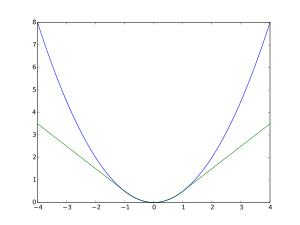Huber loss
In statistics, the Huber loss is a loss function used in robust regression, that is less sensitive to outliers in data than the squared error loss. A variant for classification is also sometimes used.
Definition

The Huber loss function describes the penalty incurred by an estimation procedure f. Huber (1964) defines the loss function piecewise by[1]
This function is quadratic for small values of a, and linear for large values, with equal values and slopes of the different sections at the two points where . The variable a often refers to the residuals, that is to the difference between the observed and predicted values , so the former can be expanded to[2]
Motivation
Two very commonly used loss functions are the squared loss, , and the absolute loss, . The squared loss function results in an arithmetic mean-unbiased estimator, and the absolute-value loss function results in a median-unbiased estimator (in the one-dimensional case, and a geometric median-unbiased estimator for the multi-dimensional case). The squared loss has the disadvantage that it has the tendency to be dominated by outliers—when summing over a set of 's (as in ), the sample mean is influenced too much by a few particularly large -values when the distribution is heavy tailed: in terms of estimation theory, the asymptotic relative efficiency of the mean is poor for heavy-tailed distributions.
As defined above, the Huber loss function is strongly convex in a uniform neighborhood of its minimum ; at the boundary of this uniform neighborhood, the Huber loss function has a differentiable extension to an affine function at points and . These properties allow it to combine much of the sensitivity of the mean-unbiased, minimum-variance estimator of the mean (using the quadratic loss function) and the robustness of the median-unbiased estimator (using the absolute value function).
Pseudo-Huber loss function
The Pseudo-Huber loss function can be used as a smooth approximation of the Huber loss function. It combines the best properties of L2 squared loss and L1 absolute loss by being strongly convex when close to the target/minimum and less steep for extreme values. This steepness can be controlled by the value. The Pseudo-Huber loss function ensures that derivatives are continuous for all degrees. It is defined as[3][4]
As such, this function approximates for small values of , and approximates a straight line with slope for large values of .
While the above is the most common form, other smooth approximations of the Huber loss function also exist.[5]
Variant for classification
For classification purposes, a variant of the Huber loss called modified Huber is sometimes used. Given a prediction (a real-valued classifier score) and a true binary class label , the modified Huber loss is defined as[6]
The term is the hinge loss used by support vector machines; the quadratically smoothed hinge loss is a generalization of .[6]
Applications
The Huber loss function is used in robust statistics, M-estimation and additive modelling.[7]
References
- Huber, Peter J. (1964). "Robust Estimation of a Location Parameter". Annals of Statistics. 53 (1): 73–101. doi:10.1214/aoms/1177703732. JSTOR 2238020.
- Hastie, Trevor; Tibshirani, Robert; Friedman, Jerome (2009). The Elements of Statistical Learning. p. 349. Archived from the original on 2015-01-26. Compared to Hastie et al., the loss is scaled by a factor of ½, to be consistent with Huber's original definition given earlier.
- Charbonnier, P.; Blanc-Feraud, L.; Aubert, G.; Barlaud, M. (1997). "Deterministic edge-preserving regularization in computed imaging". IEEE Trans. Image Processing. 6 (2): 298–311. CiteSeerX 10.1.1.64.7521. doi:10.1109/83.551699. PMID 18282924.
- Hartley, R.; Zisserman, A. (2003). Multiple View Geometry in Computer Vision (2nd ed.). Cambridge University Press. p. 619. ISBN 978-0-521-54051-3.
- Lange, K. (1990). "Convergence of Image Reconstruction Algorithms with Gibbs Smoothing". IEEE Trans. Med. Imaging. 9 (4): 439–446. doi:10.1109/42.61759. PMID 18222791.
- Zhang, Tong (2004). Solving large scale linear prediction problems using stochastic gradient descent algorithms. ICML.
- Friedman, J. H. (2001). "Greedy Function Approximation: A Gradient Boosting Machine". Annals of Statistics. 26 (5): 1189–1232. doi:10.1214/aos/1013203451. JSTOR 2699986.